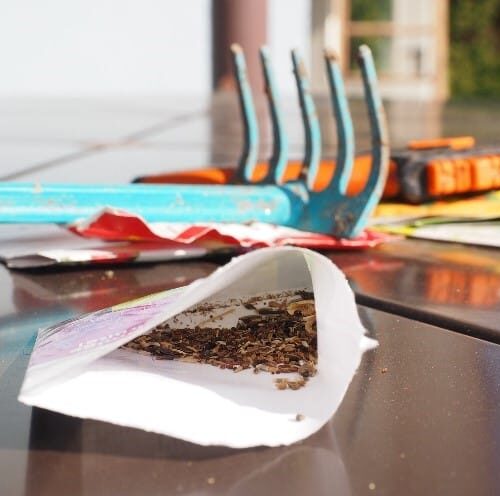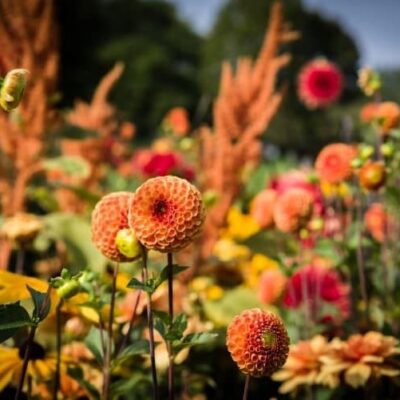September in the Garden
It’s September already: season of mists and mellow fruitfulness and all that (thank you, John Keats). There is definitely a chill in the air, and the nights are noticeably longer. There is something a bit sad about the year drawing to a close, but in September we still have plenty of flowers in bloom and leaves on the trees.
At the same time there is plenty to harvest from the allotment and vegetable garden, and even from the hedgerows, especially if you’re looking for blackberries for jam, jellies and crumbles. And we can have some beautiful weather in September: not hot and humid, as it can be in the height of summer, but warm and sunny with vivid blue skies and temperatures averaging a daily high of 18 degrees Celsius (64 degrees Fahrenheit) and a low of 10 degrees C (49 degrees F) – if we’re lucky, of course. At the moment it’s quite cold in the UK, but we live in hope…..

And there is plenty to do in the garden now. If you grow fruit and vegetables there will be crops to harvest, eat and preserve, and, if you grow flowers, you may be saving seeds from them and possibly sowing for next year. September is also a good time for planting shrubs and perennials, as the ground is still warm enough to allow their roots to establish before winter sets in, and some bulbs can be planted now. It’s also possible to take cuttings from certain plants in the garden.

Harvesting
It’s sometimes difficult to keep up with all the crops that need to be harvested at this time of year from the vegetable garden or allotment. We’ve had beans, potatoes, squash, tomatoes, garlic, lettuce, cucumbers, and beetroot, and sometimes it’s hard to know how to use them all up at the right time. On top of this, friends with a glut of fruit and vegetables are happy to give you some of those, so making jams, chutneys, soups, and sauces out of them, as well as freezing them, can be a full-time occupation. But who’s complaining? It’s also nice to be able to pass on some of your excess crops to other people.
The Gardeners’ World website has some useful ideas on preserving fruit and vegetables at this time of year. One important point that is made is that newly harvested crops should not be washed until just before preserving, as this can encourage bacteria.
Planting and Sowing
As well as being able to pick and harvest what has been growing this year, September is a good time to think about plants for next year.

Early autumn is a good time to plant most trees and shrubs so that they get established while the soil is still warm. They should be watered well after planting and once a week if the weather is dry. The same applies to hardy herbaceous perennials.
In my part of the UK, it’s very dry at the moment and the soil is difficult to work. I bought quite a few perennials as plug plants earlier in the year, and they’re ready to go out now – but the soil isn’t ready for them. I find buying plug plants is quite a good way of increasing your stock of plants inexpensively, as long as you’re prepared to look after them and keep potting them on.

If you didn’t sow biennials such as pansies and wallflowers earlier in the year, the garden centres are full of them, as well as primulas of various colours. These are useful for filling pots to provide winter colour. My favourite is still the native English primrose (primula vulgaris) that grows wild in woodland in the Spring.

There is a painting by Edward Hopley that was exhibited at the Royal Academy in 1855 and which depicts the arrival of a sole English primrose in Australia where it had been transported by sea in a Wardian case. About 3,000 people turned up to see it, such was their nostalgia for this small unassuming flower!


Bulbs
September is the month for planting many of the bulbs that flower in the Spring, such as daffodils, muscari and crocuses. Tulips are best planted in November. This video gives good advice on planting depths and shows you what the bulbs that have been planted in the Autumn look like in the Spring.

Saving and Sowing Seeds
Saving Seeds
Saving seeds from hardy annuals, perennials, and certain vegetables is an inexpensive way of multiplying the plants in your garden. The seedheads should be collected as soon as they ripen, and it’s best to do this on a dry day. The RHS recommends that they should be laid out to dry on a greenhouse bench, warm windowsill, or in an airing cupboard, which enables the seed to be more easily extracted from pods, cones, or capsules.
Some seeds (such as hellebores) need to be sown straight away, as their viability reduces with storage, but most seeds need to be stored until a more suitable time of year for sowing. They can be stored in labeled paper packets or envelopes in an airtight container and then kept in a cool, dry place – even in a fridge or freezer – until it’s time to sow them.
This video by Charles Dowding demonstrates saving seeds from vegetables.

Sowing seeds
Seeds of many plants, particularly certain hardy annuals, can be sown in the Autumn and often make stronger plants than those sown in the Spring. Sarah Raven is a particular advocate of Autumn sowing, as she explains:
“You grow a bigger, more robust plant by sowing in the autumn and it also lives and flowers for longer. If a seed germinates now, it will form a small plant, growing a few inches before going into semi-hibernation in winter. Light intensity, hours of daylight and temperatures decrease. Growth above soil level stops, but root-growth continues.
Over winter, a large root ball develops, supporting a small amount of leaf. In the early spring, light intensity, hours of daylight and temperatures increase and the plant’s away. It has had time to develop a huge root system to feed a quick-growing, plant. A seed sown in spring has pathetic prospects by comparison. The plants do fine but they won’t be flower factories like the autumn-sown.”
Another factor in favour of sowing seed in the Autumn is that it’s usually a quieter time in the garden compared with the Spring when there are so many other things to do.
Sarah Raven goes into more detail in her podcast.
Cuttings

Salvia “Hotlips”

Penstemon
Finally, this is a good time of year for taking cuttings, another inexpensive way of increasing your stock of plants in the garden. This is particularly useful for half-hardy plants such as pelargoniums and fuchsias that may not make it through the winter outside.
Semi-ripe cuttings from this year’s growth should be taken, which are woody at the base and soft at the top. Suitable plants include salvias, penstemons, lavender, lemon verbena, and helichrysum.
This video from the “Gardeners’ World” website demonstrates how to take semi-ripe cuttings.
The Beginning or the End?

Although September is officially the start of Autumn and growth in the garden is slowing down, there is still much to enjoy, and late-flowering perennials, such as Japanese anemones, hydrangeas, and dahlias provide colour, whilst the vegetable garden still provides plenty of crops. The trees are starting to turn colour and there is an altogether mellow feeling to the year.
Although the current year will soon end, September is also the start of next year’s growing season. All the clearing, sowing, weeding and planting in preparation for next year. Gardeners are always planning ahead, and so always have something to look forward to!

About the Author
Caroline Bowman has been hooked on gardening ever since she grew some thyme from seed and planted it in a window box when she lived in a flat in London. Fifty years later she is still hooked on gardening, but now she lives in Lincolnshire in England where they have quite a big suburban garden as well as an allotment, where they grow fruit and vegetables. Caroline loves flowering plants, in particular herbaceous perennials and she likes finding out about the more unusual varieties that will do well in the English climate and soil.
More from Gardenize
Images published on the Gardenize website belong to Gardenize AB and may not be used without permission.



